Undergraduates Share their Summer Experiences
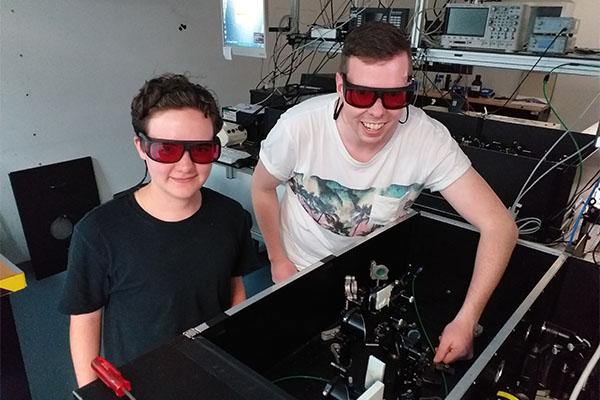
On average, 70% of students in Physics or Engineering Physics will complete at least one research or internship experience before they graduate. We caught up with four undergraduates who discussed the programs they are participating in this summer.
Liz Fuller
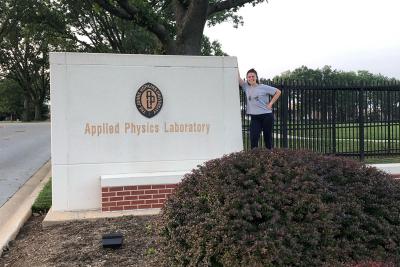
Liz is participating in an internship program at Johns Hopkins Applied Physics Lab (APL) located in Laurel, Maryland. Her project involves working with magnetic sensors and developing signal processing methods for special operations/tactical intelligence missions in the military. Liz had a lot to say about her summer experience. "The project is amazing. I feel like I’m being challenged in a way that forces me to apply my physics background to very important physical problems. The best part is that I’ve been wanting to find an internship that was at a crossroads between physics and engineering, and this is exactly It. I am actually working on multiple projects with people from multiple sectors in the lab of 7000 employees and it kinda feels like a physics playground! They work on everything from new horizons to homeland protection, there are truly no limits and I’m already interested in working full time here after I graduate." Liz went on to state that the internship experience has opened her eyes to career and post-graduation opportunities. "As I move forward in my academic and professional career I realize that there really are so many possibilities in physics. I used to think that I simply had to get a PhD and be a professor, but the reality is I can be a pseudo-engineer or a quasi-chemist, or a mixture of everything in science."
Daniel Pharis
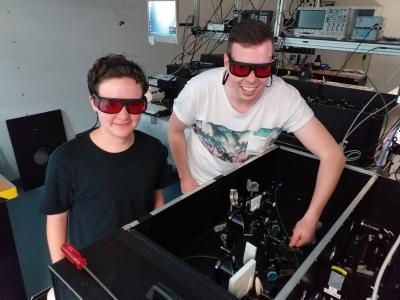
Daniel is participating in the 12-week long DAAD RISE program at Johannes Gutenberg University Mainzin in Germany. "The project I'm working on is using graphene nanoribbons to make field-effect transistors", he explained. "A lot of the stuff my research group does is similar to the research people at OSU are doing although I'm doing different things in the lab here than I do at OSU so the change is fun. There is a lot more public transit in Europe than in the US, so travel without a car is much easier, something that is very different from what I'm used to. I've been doing some traveling within Germany, as well as a bit of international travel. I was in Strasbourg for about a week for an annual graduate student seminar, which I really enjoyed. I also am going to Switzerland to do some hiking, which I'm looking forward to."
Pictured is Daniel (left) and colleague Alexander Tries in a laser lab at the Max Plank Institute for Polymer Research. In front of them is a set up that does terahertz spectroscopy which they use to characterize their samples.
Joey Masters
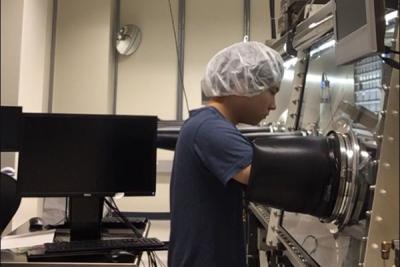
Joey is participating in the 10-week long summer research program in the Department of Physics. "This summer I worked in Dr. Roland Kawakami’s condensed matter group. I used different methods of exfoliating van der Waals materials to consistently get thin films of hexagonal boron nitride (hBN) and Fe3GeTe2 (FGT). I then learned to take these thin films and stack them in different combinations depending on what the group wanted to measure. The stacked materials, or devices, are used to induce electron tunneling, create single photon emission and more, to better understand how these materials interact with electrons and light. Understanding these materials will have many applications such as creating more efficient computer parts. This experience has helped me understand how research is conducted and has helped me decide what I want to pursue as a career."
Ari Josephson
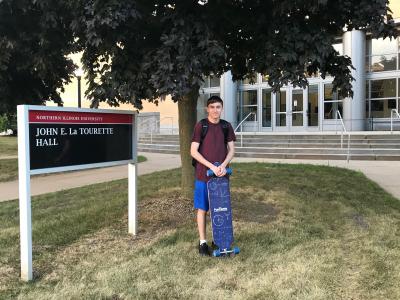
Ari spent his summer at Northern Illinois University as part of the NSF-funded Research Experience for Undergraduates (REU) program. "My project is on photon identification at the ATLAS detector at CERN. I'm working with a grad student who has developed some machine learning tools that are better at rejecting background events and my job is to apply these tools to a specific analysis involving the decay of the Higgs boson. The end goal is to show a statistically significant improvement in background rejection compared to the current photon identification standard ATLAS uses." Ari said in addition to working at Northern Illinois University, he has spent time at Argonne National Lab which is about an hour east of campus.
Current and future OSU Physics majors can find internship and research information on the undergraduate research page.
